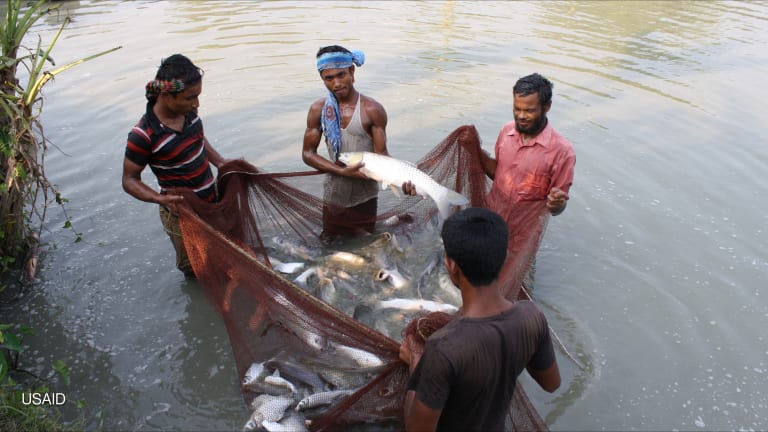
President Barack Obama’s sweeping overhaul of U.S. food aid may seem doomed as Congress chips away at his proposal in the coming days.
But behind the scenes, advocates are setting the stage for incremental reform that would have seemed unlikely even several months ago.
The debate focuses on two issues: the overall budget and the delivery mechanisms.
The Obama administration, insiders say, recognizes that the road to reform is long and its 2014 budget proposal was just a starting shot — one that had little chance of passing this year anyway since it was delayed as negotiations over the sequester dragged on.
Some signs for reform are promising: Last week, for instance, a food aid amendment to the five-year farm bill failed by only nine votes in the House of Representatives; it would allow the U.S. Agency for International Development to buy up to 45 percent of food aid locally instead of shipping surplus commodities from U.S. farmers.
Shortly thereafter, though, the farm bill failed to pass — the latest in a series of blistering setbacks for House GOP leaders. (This week, House GOP leaders zeroed in on the idea to cut the farm bill into two parts, which could make it easier to pass the portion which includes food aid.)
Meanwhile, the fiscal year 2014 agriculture appropriations bill, which includes the flagship Food for Peace program, is awaiting floor debate. Both bills have been advancing in the Senate, too, yet overall passage remains uncertain in today’s highly partisan environment.
So while Congress continues to haggle over the budget, administration officials and reform advocates are compiling ideas for food aid reform that would reduce the shipment of U.S. commodities and encourage the purchase of food produced in the developing world.
Budget woes and baby steps
The United States plans to spend $1.46 billion this year on Food for Peace, the largest U.S. food aid program.
The House is working on legislation that would cut food aid disproportionately in fiscal year 2014 by $284 million, while the Senate, after a sluggish start, advanced a bill that would up Food for Peace to $1.47 billion.
NGO association InterAction, initially called for $1.84 billion in spending, although a coalition of NGOs — among them Interaction, World Vision and the World Food Program USA — suggested $1.5 billion in a recent letter to Congress.
The tug of war over the budget will continue, but perhaps the more interesting question revolves around how that money will be spent.
For the longest time, about 85 percent of food aid was tied to the purchase of commodities from U.S. farmers and their shipment on U.S.-flagged vessels to countries in need.
Such aid takes 70-100 days longer to reach its destination than locally or regionally sourced food, though. On top of that, shipping costs have tripled over the past 10 years, cutting the purchase and shipment of commodities from 5.5 metric tons to 1.8 million metric tons.
In its fiscal year 2014 budget, the White House proposed to change the way food aid is delivered by reducing U.S. shipments and instead channeling cash more swiftly to regions experiencing food emergencies. Under the proposal, food aid would also flow through the Community Development and Resilience Fund as well as via a new Emergency Food Assistance Contingency Fund, all managed by USAID.
Resistance to Obama’s plan comes from U.S. farmers, the shipping industry and aid partners who have publicly said that the plan would put them out of business and set the economy back.
USAID Administrator Rajiv Shah insists that only 300 of 15,000 U.S. shippers would be affected and the value of America’s total agriculture would drop by 0.2 percent.
And while sweeping reform may prove unattainable this year, reform advocates remain busy brainstorming ideas that could be attached to various pieces of legislation or floated early with the Office of Management and Budget, which will begin crafting a fiscal 2015 budget in the coming weeks.
In the Senate, for instance, an amendment was attached to the farm bill that would provide $18 million more to a food aid pilot program, and eliminate $20 million in monetization, a mechanism under Food for Peace that is widely seen as wasteful, whereby aid implementers sell U.S. commodities for a profit before investing in development projects.
Another idea is to allow more money from the Food for Peace program’s so-called “safe box” to be used in emergency situations. The safe box — roughly $400 billion — now is reserved largely for non-emergency food aid, which is problematic because in hotspots like Syria, importing bulk commodities can be next to impossible.
This year, for instance, Food for Peace is already out of its flexible emergency resource, said Blake Selzer, senior policy advisor for CARE.
“If they want to do emergency cash vouchers, they can’t,” he told Devex.
Everyone expects reform to take years, but support appears to be higher than during the former George W. Bush administration, including among fiscal conservatives who see the reduction of in-kind food donations as a way to save money.
Even Royce, a California Republican, has vowed to keep trying until reform is enacted. It may take several stops and starts, but this administration, and some of its unlikely allies in Congress, are determined to progress.
John Alliage Morales contributed to this report.
Join the Devex community and access more in-depth analysis, breaking news and business advice — and a host of other services — on international development, humanitarian aid and global health.








